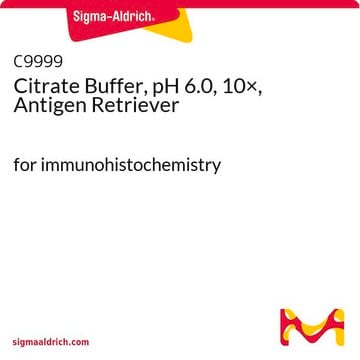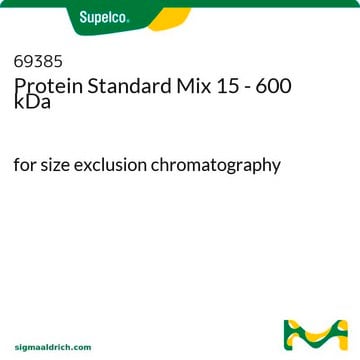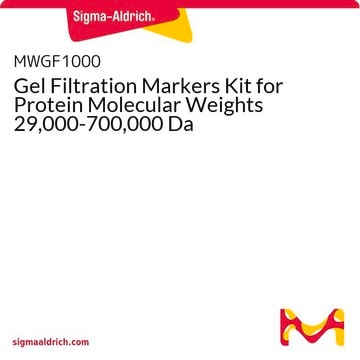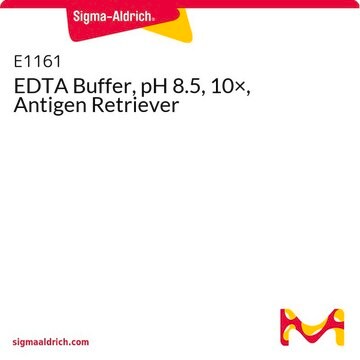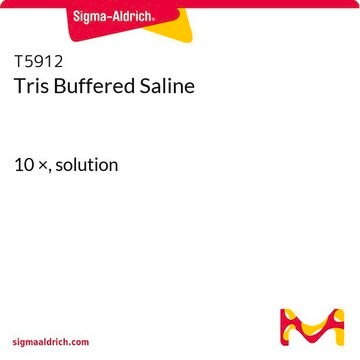Item # 920P-10 is 1 gallon of ready to use Trilogy and 920P-09 is one liter of ready to use Trilogy. No dilution is needed for either of these part numbers.
推薦產品
形狀
aqueous solution
品質等級
包裝
pkg of 1 L ready to use (920P-09)
pkg of 1 gal ready to use (920P-10)
pkg of 200 mL 20x (920P-06)
pkg of 200 mL ready to use (920P-05)
pkg of 240 mL 100x (920P-07)
pkg of 50 mL 20x (920P-04)
技術
immunohistochemistry: suitable
運輸包裝
ambient
一般說明
外觀
其他說明
法律資訊
從最近期的版本中選擇一個:
分析證明 (COA)
客戶也查看了
-
Is the Trilogy-920P-09 we purchased 20X? Do we need to dilute it before use? So we don’t need to perform deparaffinization and hydration with xylene and gradient alcohol? Also, does the solution contain Triton and Tween?
1 answer-
Helpful?
-
-
What are the differences between Trilogy and Declere, apart from Trilogy containing Triton X in its original formulation?
1 answer-
Trilogy is EDTA-based and has a higher pH than Declere, which is citrate buffer-based. Trilogy is recommended for the majority of all antibodies, while Declere is used when visualizing degrees of expression, such as with Her2Nu where the use of citrate buffer is recommended.
Helpful?
-
-
What are the troubleshooting methods for the product Trilogy 200 mL concentrate (20x) (catalogue number 920P-06)? There was a nonspecific 3,3'-diaminobenzidine (DAB) signals in IHC experiments on paraffin-embedded kidney sections using the 1x Trilogy buffer and a rice cooker for the heating steps. Is there a suggestion for optimizing the antigen retrieval steps of Trilogy to achieve a milder unmasking effect?
1 answer-
The issue could be related to fixation. A protocol for use in a steamer involves using 50mls to make 1 liter of solution, with 30 minutes in the steamer and 30 minutes in hot rinse with agitation and no cool down. Subsequently, rinsing with wash buffer is crucial, requiring several rinses for cleaner staining. An alternative option is to use Trilogy to deparaffinize and rehydrate, leaving it in the steamer for 60 minutes before proceeding to rinsing.
Helpful?
-
-
Can you provide information regarding how Trilogy was made?
1 answer-
The EDTA-based buffer is a concentrate that needs to be diluted as 20X.
Helpful?
-
-
Is Trilogy a fully aqueous solution or does it contain any organic solvent? How does the deparaffinization process using Trilogy compare to the process using organic solvents and a series of alcohol concentrations? Can Trilogy be reused, and is there a protocol available for using it? Additionally, is it necessary to extend the time of deparaffinization when using large FFPE sections of human brain with Trilogy?
1 answer-
Trilogy is an EDTA-based buffer with a variable pH of 7.8 to 8.8. It also contains some detergents/surfactants. An automatic pressure cooker is recommended for use as it tends to give the most consistent results. It may take some experimentation to work with a pressure cooker for the brain specimens to ensure that you do not experience any adhesion issues. Another heat source option might be a steamer, but this will take longer (45 minutes to an hour) for the process to be complete for unmasking. Also, the second container used for rinsing during the initial process can be refrigerated for use as the starting buffer for the next batch of slides.
Helpful?
-
-
Can Trilogy be re-used, and is it used with the PT Module or other automation?
1 answer-
There is no official data to support the reusability of the product.
Helpful?
-
-
What is the pH of 1X Trilogy reagent
1 answer-
The concentrate product Trilogy has a variable pH ranging from 7.8 to 8.8.
Helpful?
-
Active Filters
我們的科學家團隊在所有研究領域都有豐富的經驗,包括生命科學、材料科學、化學合成、色譜、分析等.
聯絡技術服務

